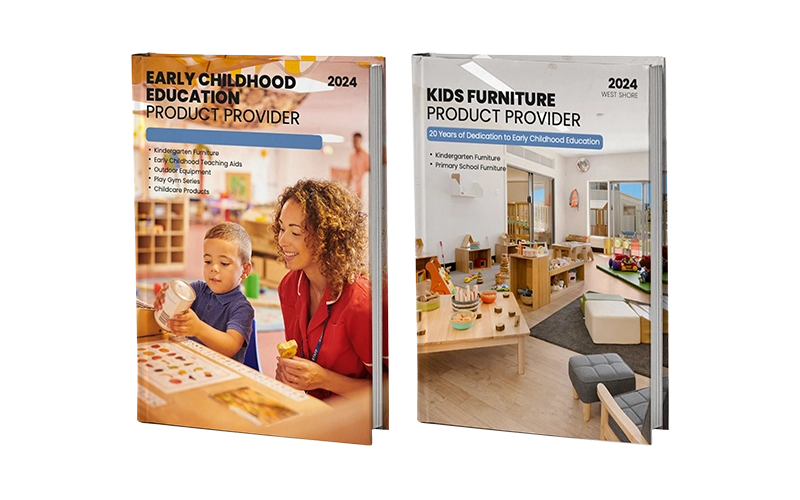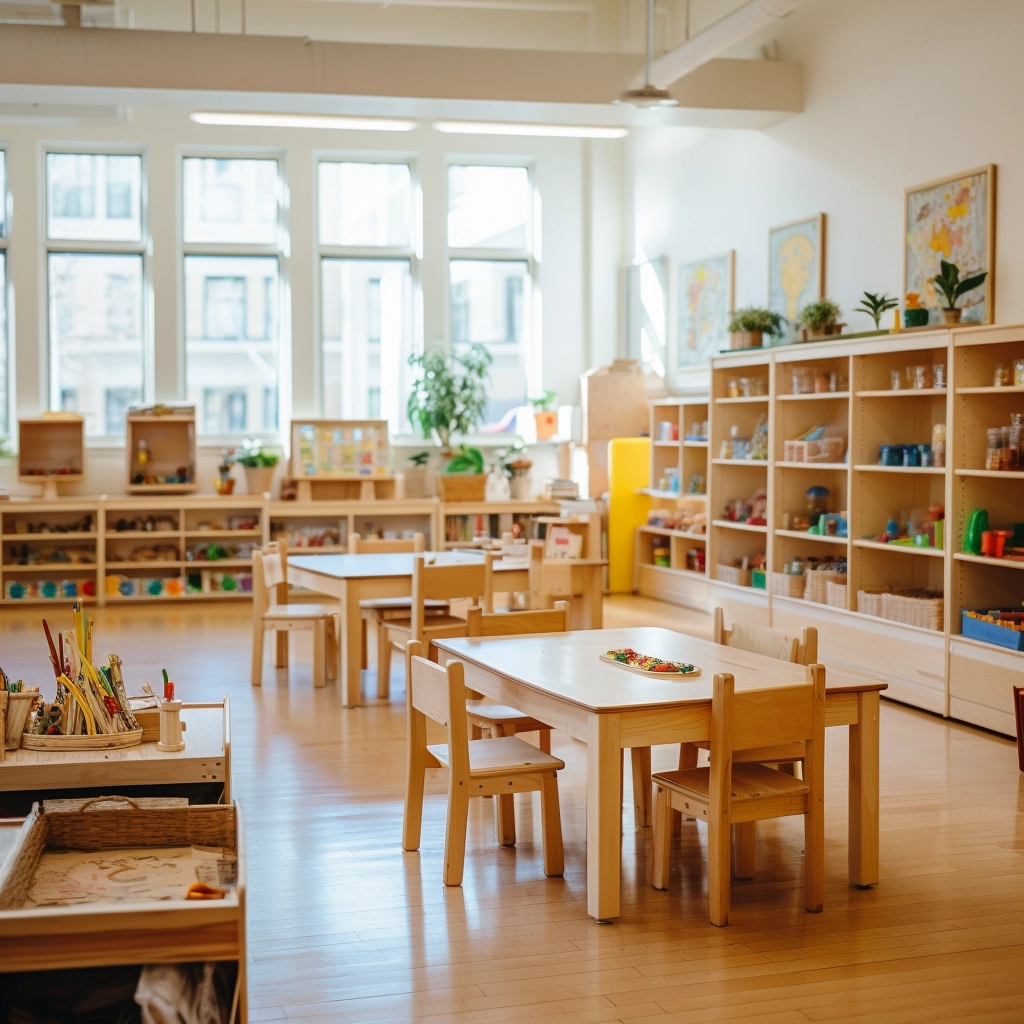Did you know that children in Montessori classrooms show significant gains in executive function, reading, and math skills compared to their peers in traditional settings? This is just one of the many benefits associated with the Montessori method, an educational approach that has been fostering children’s natural love of learning for over a century. 1 At West Shore Furniture, we believe in the power of creating environments that inspire creativity, independence, and a lifelong passion for exploration. In this comprehensive guide, we’ll delve into the key elements of a Montessori classroom and provide you with the tools and knowledge to create a nurturing and engaging learning space for your child, whether at home or in a school setting.
What is the Montessori Method?
Developed by Dr. Maria Montessori, an Italian physician and educator, the Montessori method is a child-centered approach that emphasizes self-directed learning, hands-on activities, and a carefully prepared environment. It recognizes that children have an innate desire to learn and provides them with the freedom to explore their interests at their own pace.

Key characteristics of the Montessori method include:
- Focus on the whole child: Montessori education considers the child’s physical, social, emotional, and cognitive development.
- Sensitive periods: It recognizes that children go through specific periods of development where they are particularly receptive to learning certain skills.
- Prepared environment: The learning environment is carefully designed to be aesthetically pleasing, organized, and accessible to children.
- Auto-education: Children are encouraged to learn independently through self-discovery and exploration.
- Teacher as a guide: The teacher acts as a facilitator, observing children and providing guidance and support as needed.
Key Principles of a Montessori Classroom
A Montessori classroom is more than just a physical space; it’s a carefully curated environment designed to promote independent learning, exploration, and a sense of order. Here are some key principles that guide the design and function of a Montessori classroom:
- Freedom within limits: Children are given the freedom to choose their activities and work at their own pace, but within a framework of clear expectations and guidelines.
- Respect for the child: Children are treated with respect and dignity, and their individual needs and interests are valued.
- Auto-education: The environment is designed to encourage self-directed learning, with materials that are self-correcting and allow children to learn from their mistakes.
- Sensory exploration: Montessori classrooms provide ample opportunities for children to engage their senses through hands-on activities and materials.
- Order and beauty: The classroom is organized and aesthetically pleasing, creating a sense of calm and harmony that promotes focus and concentration.
Essential Elements of a Montessori Classroom
Creating an authentic Montessori environment involves incorporating key elements that foster a child’s natural curiosity and love of learning. Here’s what you need to consider:
- Child-sized furniture: Furnish the classroom with child-sized tables, chairs, and shelves that are easily accessible to children. This promotes independence and allows them to take ownership of their learning space. West Shore Furniture offers a beautiful selection of [child-sized furniture](link to relevant product category) crafted from sustainable materials and designed with Westshore Furniture aesthetics in mind.
- Open shelving: Use open shelves to display Montessori materials in an organized and visually appealing way. This allows children to see and choose the activities that interest them. Consider our range of [shelving units](link to relevant product category) designed to fit seamlessly into any Montessori environment.
- Natural light and natural elements: Maximize natural light and incorporate natural elements such as plants, flowers, and natural materials like wood and wool. This creates a calming and inviting atmosphere.
- Practical life area: Dedicate a space for practical life activities, such as pouring, scooping, and buttoning. These activities help children develop fine motor skills, coordination, and concentration.
- Sensorial area: Create a sensorial area with materials that engage the five senses, such as textured fabrics, sound cylinders, and color tablets.
- Language area: Include a language area with books, writing materials, and activities that promote literacy development.
- Math area: Set up a math area with manipulatives, counting materials, and activities that introduce mathematical concepts.
- Cultural area: Incorporate a cultural area with maps, globes, and artifacts that expose children to different cultures and traditions.
Age-Appropriate Montessori Materials and Furniture

Choosing the right materials and furniture is crucial for creating a successful Montessori classroom. Consider the age and developmental stage of the children when selecting materials.
- Infants (0-18 months): Focus on providing a safe and stimulating environment with soft textures, mobiles, and simple toys that encourage grasping and reaching.
- Toddlers (18 months-3 years): Offer practical life activities, sensorial materials, and simple puzzles. Choose sturdy, child-sized furniture that can withstand active play.
- Preschoolers (3-6 years): Introduce more complex activities, such as language materials, math manipulatives, and art supplies. Provide comfortable seating options for group activities and individual work.
Setting Up a Montessori Classroom at Home
You don’t need a dedicated classroom to bring Montessori principles into your home. Here are some tips for creating a Montessori-inspired learning space in any home environment:
- Define the space: Choose a dedicated area for your child’s learning activities, whether it’s a corner of the living room or a spare bedroom.
- Declutter and organize: Keep the space tidy and organized, with materials neatly arranged on shelves.
- Rotate materials: Rotate materials regularly to keep children engaged and interested.
- Incorporate natural elements: Bring in natural light, plants, and natural materials to create a calming and inviting atmosphere.
- Create a “yes” space: Ensure the space is safe and child-friendly, allowing children to explore freely without constant restrictions.
Creating a Prepared Environment
The concept of a “prepared environment” is central to Montessori philosophy. It refers to a carefully designed space that supports children’s independence, exploration, and learning. Here are some key features of a prepared environment:
- Order: Materials are organized and accessible, allowing children to easily find what they need.
- Aesthetics: The environment is visually appealing and inviting, with natural light and natural elements.
- Freedom of movement: Children have the freedom to move around and choose their activities.
- Child-sized furniture: Furniture is scaled to the child’s size, promoting independence and accessibility.
- Real-life tools: Children are provided with real-life tools and materials, such as child-sized brooms, dustpans, and gardening tools.
Practical Life Activities in the Montessori Classroom
Practical life activities are a cornerstone of Montessori education. They involve everyday tasks that help children develop fine motor skills, coordination, concentration, and independence. Examples include:
- Pouring: Pouring water or dry goods from one container to another.
- Scooping: Scooping beans or rice with a spoon.
- Transferring: Transferring objects using tongs or tweezers.
- Buttoning and zipping: Practicing buttoning and zipping clothes.
- Washing dishes: Washing and drying dishes.
- Sweeping and mopping: Cleaning up spills and sweeping the floor.
Sensorial Activities for Montessori Learning
Sensorial activities engage children’s senses and help them develop their perception of the world around them. Here are some examples:
- Visual discrimination: Matching colors, sorting objects by size or shape.
- Auditory discrimination: Identifying different sounds, matching sounds to objects.
- Tactile discrimination: Exploring different textures, sorting objects by roughness or smoothness.
- Olfactory discrimination: Identifying different smells, matching smells to objects.
- Gustatory discrimination: Exploring different tastes, identifying sweet, sour, salty, and bitter flavors.
Incorporating Montessori Principles into Any Classroom
Even if you’re not in a full-fledged Montessori setting, you can still incorporate Montessori principles into your classroom or home learning environment. Here are some ideas:
- Provide choices: Offer children choices in their activities and learning materials.
- Encourage independence: Encourage children to do things for themselves, such as getting dressed, cleaning up, and choosing their own activities.
- Create a sense of order: Keep the learning environment organized and clutter-free.
- Use hands-on materials: Provide opportunities for hands-on learning with manipulatives, real-life objects, and open-ended materials.
- Observe and follow the child: Pay attention to children’s interests and developmental needs, and adjust your approach accordingly.
Creating a Peaceful Montessori Classroom
The atmosphere in a Montessori classroom plays a crucial role in fostering concentration and a sense of calm. Here are some tips for creating a peaceful and harmonious learning environment:
- Neutral color palettes: Opt for calming, neutral colors for walls and furnishings. Soft hues of green, blue, and beige create a serene backdrop for learning.
- Clutter-free environment: Keep the space tidy and organized. Avoid excessive decorations and visual clutter that can be distracting for children.
- Natural materials: Incorporate natural materials like wood, wool, and cotton. These materials have a calming effect and contribute to a more peaceful atmosphere.
- Soft lighting: Use soft, natural lighting whenever possible. Avoid harsh fluorescent lights which can be overstimulating.
- Sound absorption: Consider using rugs, curtains, and other soft furnishings to absorb sound and minimize distractions.
- Designated quiet areas: Create designated quiet areas where children can retreat for individual work or moments of calm.
Observing Children in a Montessori Environment
Observation is a key tool for Montessori educators. By carefully observing children, teachers can gain insights into their interests, developmental needs, and learning styles. This information can then be used to guide lesson planning and create individualized learning experiences.
Here are some tips for effective observation:
- Be unobtrusive: Observe children without interrupting their activities or drawing attention to yourself.
- Focus on the process: Pay attention to the process of learning, not just the end result.
- Take notes: Record your observations in a notebook or journal.
- Look for patterns: Identify patterns in children’s behavior and interests.
- Share your observations: Share your observations with parents and colleagues to gain further insights and collaborate on strategies to support each child’s development.
Role of the Teacher in a Montessori Classroom
In a Montessori classroom, the teacher’s role is that of a guide and facilitator, rather than a traditional instructor. They prepare the environment, observe the children, and offer guidance and support as needed. Montessori teachers:
- Create a prepared environment: Ensure the classroom is organized, aesthetically pleasing, and equipped with age-appropriate materials.
- Observe children: Carefully observe children to understand their interests, needs, and learning styles.
- Introduce materials: Introduce new materials and activities to children, demonstrating their proper use.
- Facilitate learning: Guide children’s learning by providing support, answering questions, and encouraging exploration.
- Foster independence: Encourage children to work independently and take ownership of their learning.
- Build community: Create a sense of community within the classroom, fostering respect, collaboration, and empathy among children.
Addressing Inclusivity in the Montessori Classroom
Montessori education is founded on the belief that every child has the potential to learn and thrive. Adapting the Montessori environment and approach for children with diverse learning needs and abilities is key to ensuring an inclusive and supportive learning experience for all.
Here are some strategies for creating an inclusive Montessori classroom:
- Provide individualized support: Offer individualized support and accommodations based on each child’s specific needs. This may involve modifying materials, providing assistive technology, or adjusting the pace of learning.
- Flexible learning environment: Create a flexible learning environment that can be adapted to meet the needs of different learners. This may include providing quiet spaces for children who are easily overstimulated, or offering alternative seating options for children with physical limitations.
- Collaborative learning: Encourage collaborative learning activities that allow children to learn from and support each other.
- Celebrate diversity: Celebrate the diversity of learners in the classroom and create a culture of acceptance and belonging.
- Ongoing assessment: Continuously assess children’s progress and adjust your approach as needed.
Technology in the Modern Montessori Classroom
While traditional Montessori classrooms have limited the use of technology, there is a growing recognition of the potential benefits of technology when integrated thoughtfully and purposefully.
Here’s how technology can be incorporated into a modern Montessori environment:
- Research and exploration: Use tablets or computers for research projects, virtual field trips, and exploring different cultures.
- Creative expression: Encourage children to use technology for creative expression through digital art, music composition, and storytelling.
- Coding and robotics: Introduce age-appropriate coding activities and robotics to foster problem-solving skills and logical thinking.
- Assistive technology: Utilize assistive technology to support children with learning differences.
- Mindful screen time: Establish clear guidelines for screen time and ensure that technology is used in moderation and with intention.
Sustainability in the Montessori Classroom
Sustainability is an important value to instill in children from a young age. Here’s how to incorporate sustainable practices into your Montessori classroom:
- Eco-friendly materials: Choose furniture and materials made from sustainable and non-toxic materials, such as bamboo, recycled plastic, and organic cotton.
- Reduce, reuse, recycle: Implement a recycling program and encourage children to reduce waste and reuse materials whenever possible.
- Nature exploration: Connect children with nature through outdoor activities, gardening, and nature walks.
- Energy conservation: Teach children about energy conservation by turning off lights when leaving a room and using natural light whenever possible.
- Composting: Start a compost bin in the classroom to reduce food waste and teach children about the decomposition process.
Inspiring Curiosity: Westshore Furniture Design Influences in Montessori Spaces
While the core principles of Montessori remain constant, the aesthetic of a Montessori classroom can be adapted to reflect regional styles and preferences. On the Westshore Furniture, where a love for nature and a minimalist aesthetic prevail, Montessori spaces often incorporate elements that evoke a sense of calm and connection to the natural world.
Here are some ways to infuse Westshore Furniture design influences into your Montessori environment:
- Natural materials: Embrace natural materials like wood, bamboo, and cotton. These materials not only create a calming and inviting atmosphere but also align with the Westshore Furniture‘s emphasis on sustainability and eco-consciousness.
- Neutral color palettes: Opt for a neutral color palette with soft hues of gray, blue, green, and beige. These colors create a sense of tranquility and allow the natural beauty of the materials to shine through.
- Minimalist aesthetic: Embrace a minimalist approach to décor and furnishings. Avoid clutter and excessive decorations, focusing instead on creating a clean and uncluttered space that promotes focus and concentration.
- Indoor-outdoor connection: Maximize natural light and create a seamless connection between indoor and outdoor spaces. This can be achieved through large windows, sliding doors, and access to a patio or garden.
- Natural elements: Incorporate natural elements such as plants, flowers, and natural textures like wool and linen. These elements bring the outdoors in and create a sense of peace and tranquility.
By incorporating these Westshore Furniture design elements, you can create a Montessori environment that is both aesthetically pleasing and conducive to learning.
Quick Tips for Setting Up a Montessori Classroom
Ready to create your own inspiring Montessori space? Here are some quick tips to get you started:
- Declutter and organize: A clutter-free environment promotes focus and concentration.
- Child-sized furniture: Choose furniture that is scaled to the child’s size, allowing for independence and accessibility.
- Open shelving: Use open shelves to display materials in an organized and visually appealing way.
- Natural light and natural elements: Maximize natural light and incorporate plants and natural materials.
- Practical life area: Dedicate a space for practical life activities, such as pouring, scooping, and buttoning.
- Sensorial area: Create a sensorial area with materials that engage the five senses.
- Rotate materials: Rotate materials regularly to keep children engaged and interested.
Addressing Reader Questions: FAQs about Montessori Classrooms
What is the difference between Montessori and traditional classrooms?
Montessori classrooms emphasize self-directed learning, hands-on activities, and a prepared environment, while traditional classrooms typically follow a more teacher-centered approach with structured lessons and standardized testing.
What are the benefits of Montessori education?
Montessori education has been shown to foster independence, self-confidence, a love of learning, and strong academic skills.
How much does it cost to set up a Montessori classroom?
The cost of setting up a Montessori classroom can vary depending on the size of the classroom, the materials used, and whether you are setting it up at home or in a school. However, there are many ways to create a Montessori-inspired learning environment on a budget.
What are some examples of Montessori activities?
Montessori activities include practical life exercises (pouring, scooping, buttoning), sensorial activities (exploring textures, matching colors), language activities (reading, writing, storytelling), and math activities (counting, sorting, measuring).
Where can I find Montessori-trained teachers?
You can find Montessori-trained teachers through the American Montessori Society (AMS) or the Association Montessori Internationale (AMI).
Conclusion
Creating an inspiring Montessori classroom is an investment in a child’s future. By carefully designing the learning environment and incorporating the key elements of Montessori education, you can foster a love of learning, independence, and a strong foundation for future success.
At West Shore Furniture, we are passionate about creating beautiful and functional spaces that inspire creativity and exploration. We offer a wide selection of Montessori-inspired furniture and décor, crafted from sustainable materials and designed with West Coast aesthetics in mind.
Browse our collection today and start building your dream Montessori classroom!

Need help designing your space? Contact our design experts for personalized assistance.







